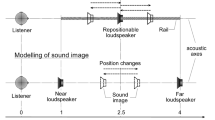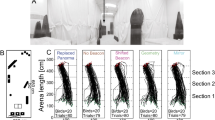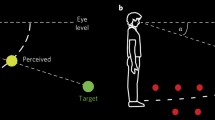Summary
When ambulatory subjects wear prisms with bases vertically opposed before the two eyes, the direction of the after-effect measured on a localization task shows that there is a bias favouring selection of the field which contains more of the floor. Subjects allowed differential views of the floor with prism bases laterally opposed also show this bias. The bias is reversed if flow patterns from the lower visual field are eliminated. These studies support the view that information in the lower ambient field is selectively utilized during locomotion.
Similar content being viewed by others
References
Foley, J. E.: Prism adaptation with opposed base orientation: the weighting of direction information from the two eyes. Perception and Psychophysics, 8, 23–25 (1970a)
Foley, J. E.: Prism adaptation with simultaneous receipt of normal input. Perception and Psychophysics, 8, 393–395 (1970b)
Foley, J. E.: Factors governing interocular transfer of prism adaptation. Psychol. Rev., 81, 183–186 (1974)
Foley, J. E., Miyanishi, K.: Interocular effects in prism adaptation. Science, 165, 311–312 (1969)
Gibson, E. J.: Principles of perceptual learning and development. Appleton-Century Crofts, New York, 1969
Gibson, J. J.: The senses considered as perceptual systems. Boston: Houghton Mufflin, 1966
Gibson, J. J.: What gives rise to the perception of motion? Psychol. Rev., 75, 335–346 (1968)
Held, R.: Adaptation to rearrangement and visual-spatial aftereffects. Psychol. Beitr. 6, 439–450 (1962)
Held, R.: Dissociation of visual functions by deprivation and rearrangement. Psychol. Forsch., 31, 338–348 (1968a)
Held, R.: Action contingent development of vision in neonatal animals. Chapter in: Experience and Capacity, D. P. Kimble (ed.), New York: Academy of Science 1968b
Ingle, D.: Two visual mechanisms underlying the behaviour of fish. Psychol. Forsch. 31, 44–51 (1967)
Kaufman, L.: Sight and Mind. New York: Oxford University Press 1974
Kohler, I.: The formation and transformation of the perceptual world. Psychological Issues, Monograph 12, 3 (1964)
McChesney, J.: Prism adaptation with opposed base orientations: the weighting of directional information and information concerning the floor. M. A. Thesis, University of Toronto, 1970
Schneider, G. E.: Contrasting visuomotor functions of tectum and cortex in the golden hamster. Psychol. Forsch., 31, 52–62 (1967)
Taylor, J. G.: The behavioural basis of perception. New Haven: Yale University Press 1962
Trevarthen, C. B.: Two mechanisms of vision in primates. Psychol. Forsch., 31, 299–337 (1968)
Author information
Authors and Affiliations
Additional information
This research was supported by Grant No. APA-1 from the National Research Council of Canada. Experiment 4 and a first replication of Experiment 1 were part of a thesis submitted by the junior author for the M.A. degree at the University of Toronto.
Rights and permissions
About this article
Cite this article
Foley, J.E., McChesney, J. The selective utilization of information in the optic array. Psychol. Res 38, 251–265 (1976). https://doi.org/10.1007/BF00309775
Received:
Issue Date:
DOI: https://doi.org/10.1007/BF00309775




